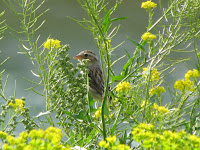 |
| Lookout at Fish Creek - Burnmeade |
I started my birding on day 2 at 6:30 AM by the ponds at Burnmeade. I added a first for the trip, American Wigeon (Mareca americana). I again crossed the bridge to the McKenzie
Meadows golf course side of the Bow River and followed the path down to the Highway
201 overpass at Stoney Trail. I then
crossed over to the other side of the river and followed it back up to my
starting point at Burnmead, a journey of roughly 6 ½ miles (10.5km).
On my way down to the highway, I added a few more lifers including the two nuthatches – the Red and the White-bellied nuthatches (Sitta canadensis and Sitta carolinensis respectively). I also met the lady who promised, the day before, to bring me a few birdseeds to feed the Chickadees. She kept her
promise and presented me
with a clear ziplock bag full of sunflower seeds, about ¼lb in weight. I was happy to see her not waiting around to see if I would use them but we both continue going in opposite directions. As I was crossing over to the other side of
the river, using the pedestrian crossing next to the highway, I could not help
but notice an enormous Osprey (Pandion haliaetus) nest on one of the
sign poles. Even though Ospreys are common
migrants to Barbados, they don’t nest there, making this the first time I was seeing
a nest. As the week continued I would
even see a nest with chicks. On the
return trip to Burnmead, my most exciting sighting was a Sharp-shinned Hawk (Accipiter striatus), that was being harassed by
an Eastern Kingbird (Tyrannus tyrannus). The complete journey took 3 ½ hours and I saw
12 new birds for the trip, 9 of which were lifers.
On my way down to the highway, I added a few more lifers including the two nuthatches – the Red and the White-bellied nuthatches (Sitta canadensis and Sitta carolinensis respectively). I also met the lady who promised, the day before, to bring me a few birdseeds to feed the Chickadees. She kept her
 |
| Osprey Nest |
Glenmore Park and Reservoir
 |
| Sunset at Glenmore Reservoir |
In the evening around 8 pm, my uncle took me to South
Gilmore’s Park to see the sunset, yes the sunset! It was a very beautiful space with lots of
people involved in outdoor activities. As
it was at Fish Creek, many persons were walking dogs, walking, jogging or
biking. The reservoir was a big lake. Persons
were fishing and boating on it but no one was swimming or playing in the water
– I was told that it was not allowed. I
met a family on the trail next to the lake picking small berries, which I
tried. They had a sweet but soft flavor. They were called Saskatoon berries and can
be used in making jams, jellies, preservatives, etc.
Birds were all around. The ever-present Ring-billed
Gull (Larus delawarensis) was everywhere, at the parks, at the malls,
supermarkets, carparks, much like our
Cattle Egrets. They were the Cattle
Egrets of Calgary. Ducks were on the
lake – the ubiquitous Mallard (Anas
platyrhynchos), Redhead (Aythya
Americana), Bufflehead (Bucephala albeola) and Common Goldeneye (Bucephala clangula). I also saw what looked like a grebe but it
was too far away to make a positive identification.
I followed a loud, high pitched bird call into
a wooded area and came upon an immature raptor. I took a few photographs of it before it flew
over to another raptor, which I assumed was a parent. The immature bird showed brownish uppers and a
brown barring on belly and chest. The
adult was more of a lighter gray. I know
that these were either Cooper or Sharp-shinned Hawks but the similarity between
these two species made identification difficult. I sent the photographs to Gavin McKinnon, a
local birder and he told me that the tail shapes are important in separating
these raptors, without that, its almost impossible to do so.
I added 5 new birds from Glenmore Park to my Canadian
checklist, 4 of which were lifers.
New Species for the
Day: 17
New Lifers for the Day: 13
Total Species for the Trip: 50
Total Lifers for the Trip: 36
New Lifers for the Day: 13
Total Species for the Trip: 50
Total Lifers for the Trip: 36
American Wigeon;
Warbling Vireo; Tree Swallow; Cliff Swallow; Red-breasted Nuthatch; White-breasted Nuthatch; European Starling; Gray
Catbird; Pine Siskin; Common Grackle; Great Blue Heron; Sharp-shinned Hawk; Redhead; Bufflehead; Common
Goldeneye; Spotted Sandpiper;
Red-eyed Vireo
Ps. I was surprised to see Red-eyed Vireo as a lifer since I
saw and recorded this bird in Trinidad 2016.
A quick check clarifies this. In
2018 Red-eyed Vireo (Vireo olivaceus) was split into two
species, Red-eyed Vireo and Chivi Vireo (Vireo chivi).
A Few Images from Day 2











No comments:
Post a Comment